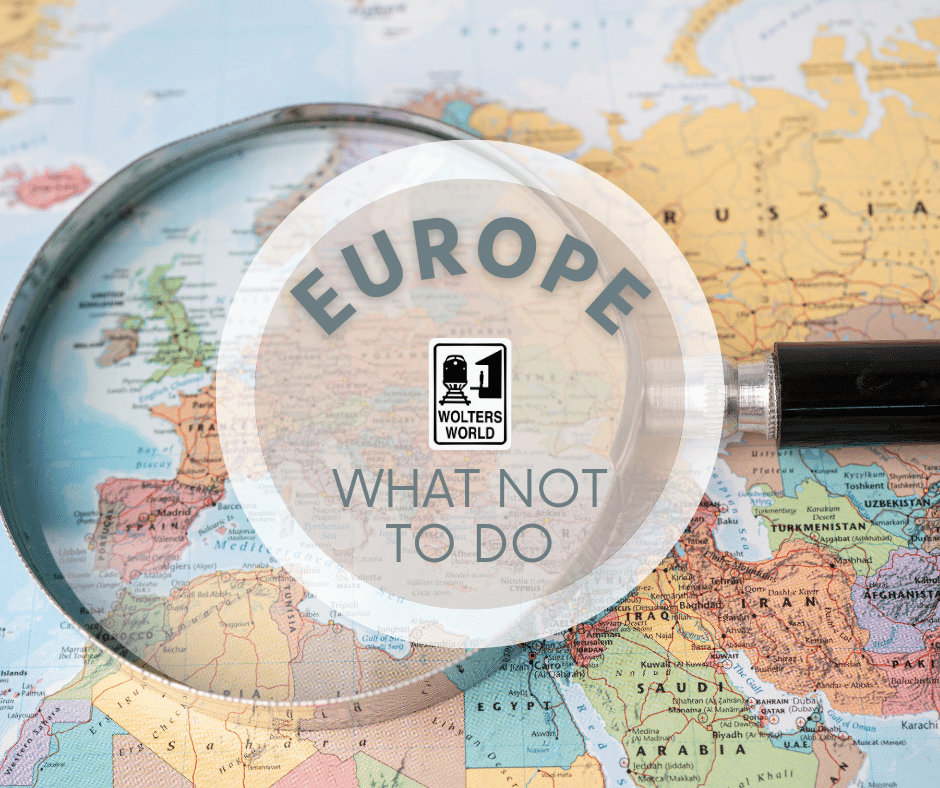Hey there, fellow travelers! Today, we’re discussing what NOT to do when visiting Europe. While many travel blogs will give you tips for European travel, we want to be sure you know about the things you should NOT do when you plan a trip to Europe.

Don’t Lump All of Europe Together
While we’re doing just that for this blog post, remember that Europe has 50 countries, and the variety of cultures and climates is astounding. You simply cannot compare Poland to Portugal, or Finland to France. Just because you’ve been to London, doesn’t mean you’ve “seen Europe.” If you have a bad time in one part of Europe, don’t write off the rest of the continent!
Don’t Overpack
Our best tips for European travel are for packing. Don’t overpack!!! The less stuff you pack, the more likely you will enjoy traveling around Europe. Part of experiencing new cultures is shopping for groceries or clothes or visiting the local pharmacy. Besides, cobblestone streets are not very comfortable for dragging a suitcase around and if you are struggling with your luggage, it makes you an easy target for pickpockets.
Don’t Forget to Explore Beyond the Museums
Yes, Europe has incredible museums and by all means, you should visit museums in Europe if it interests you. But don’t forget that European culture is a living, breathing, evolving aspect of your European travels.
Enjoying dinner with locals or a picnic in the park is just as enjoyable as going to the most popular tourist attractions. The more time you spend away from the tourist attractions, the better you will begin to see the culture of the country you are visiting.
Don’t Be Afraid to Explore Europe
For many travelers, London or Paris is often the “intro to Europe” and many travelers stick to these popular cities, as well as Rome, Dublin, or Athens. A lot of capital cities are homogenized and international, while the smaller villages and towns still hold that authentic European feel.
Europe is super easy to get around, so there’s nothing to lose by exploring some smaller villages during your travels.

Don’t Skip Public Transportation
If you’re from the United States and you’ve never been to Europe, the public transportation options will blow you away. It is so easy to get around, whether by bus, train, or subway. You’ll get a better feel for the culture as you commute with locals, and you’ll save a lot of money over taking taxis or rideshares. In cities with a lot of traffic, taking the subway will even save you time as you’re not stuck in traffic.
Five Things You’ll Love & Hate About Europe
But remember: don’t be loud on public transportation! Most European cultures are more subdued than American culture, so being loud can be frowned upon. Some trains have special quiet cars, but regardless of what car you are in, take a cue from your fellow passengers. If it’s pretty quiet except for your group, consider taking it down a notch.
Don’t Be Fooled by Cheap Flights
When you are traveling within Europe, there are several low-cost carriers like RyanAir that will tempt you with very cheap flights. But keep in mind, these airlines are going to have “a la carte” pricing so you will pay for seat assignments, luggage, or food. And they often fly into more remote airlines, which means you might have a 40 Euro flight but then spend 60 Euros to take a taxi into the city! Just make sure to examine all options when planning your travel within Europe.
Don’t Worry About Safety in Europe
Of course, this is a blanket statement, but don’t ruin your trip with excessive worrying. There may be pickpockets and scammers, but if you keep your wits about you and use common travel sense, you shouldn’t have any major issues.
Don’t Forget a PIN for Your Credit or Debit Card
Some places in Europe will require you to have a PIN for a credit card transaction. You’ll also need one to withdraw cash when you arrive. Some places don’t take cash, others may only take cash, so always have a couple of payment options at your disposal. And make sure you get the PIN for your credit cards as well as your debit cards before you leave.
Visa and MasterCard are the most widely accepted. If American Express is your primary card, make sure you have a backup card as a lot of places still don’t take American Express.
You should also make sure you have some small bills on hand, as a lot of merchants prefer not to take larger bills. It’s not uncommon to find a bathroom that costs a few coins to enter, so that’s another good reason to have some loose change. This is very common at train stations but also applies to some restaurants and bars as well.
Don’t Expect “Over the Top” Service in Europe
Most European servers don’t rely on tips as their main source of income, so you’re not going to see the overly friendly and attentive service that you are used to in the United States. Service may take longer as well, as Europeans have a more relaxed approach to dining. Most places don’t mind if you take a table for hours at a time because that’s the culture.

Don’t Forget a Power Adapter
Your U.S. plugs won’t work in most European outlets, and the outlet types may change from one country to another. Most adapters you can buy have different types of plugs on each side, so it’s pretty easy to transition from one place to the next. Newer travel adapters typically have USB ports as well, so you can charge all of your devices at once.
Don’t Forget to Learn a Few Words
No matter where you are traveling, it’s always a good idea to learn a few words in the local language. Hello, please, and thank you will go a long way with the locals! They do not expect you to be fluent, and they won’t fault you for mistakes. It will simply show that you’ve made an effort to learn about your destination before visiting.
If you are speaking English and having a hard time getting your message across, speaking louder is not going to help. That’s when it’s time to whip out your phone and use a translation app!
Tips for Learning a Foreign Language
Don’t Forget About Regionality in Europe
We’ve already established that you can’t lump all of Europe together. But even within a specific country, there are vastly diverse regions. Germany has a strong Bavarian culture in the southern part of the country, and Barcelona is part of Catalonia, which has the heaviest influence on the culture there. It’s no different than lumping Texans in with New Yorkers and Californians.
Don’t Get Discouraged
Before you visit a European city, you’re going to have an idea of what to expect. But Europe is not Disney World; there are good and bad parts no matter where you go. Sometimes you might have to learn the hard way about some differences in cultures, but don’t let it get you down. If you don’t love Paris, that doesn’t mean you won’t love other places in France or in Europe. Don’t let one place ruin all of Europe for you.
This also applies to stereotypes, both good and bad. Go into your European travels with an open mind, and learn as you go, rather than bringing your preconceived stereotypes and expectations with you. You just might be pleasantly surprised.
Grab Some Wolters World Travel Gear!
We love visiting Europe any chance we get. I have lived in several European countries and enjoy experiencing the different cultures and regions within Europe. Keep an open mind and don’t be afraid to go off the beaten path when you visit.
Need more travel tips in Europe? Check out these blog posts!